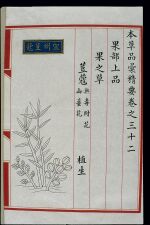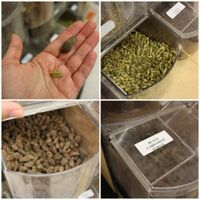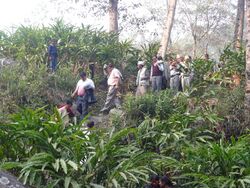Biology:Cardamom production
Cardamom production employs plants of the genera Elettaria and Amomum in the ginger family Zingiberaceae. Cultivation of cardamom was introduced to Guatemala before World War I by Oscar Majus Kloeffer; today Guatemala is the world's biggest producer and exporter, followed by India and Sri Lanka. Saudi Arabia and Kuwait are the leading importers of the spice. After saffron and vanilla, cardamom is the third most expensive spice by weight.
History
The scientific name for the cardamom genus Elettaria derives from the Tamil name for "cardamom seeds". Production began in ancient times, and it has been referred to in ancient Sanskrit texts as "Ela".[1] The Babylonians and Assyrians recognized the health benefits of the spice early on, and trade in cardamom opened up along land routes and by the interlinked Persian Gulf route controlled from Dilmun as early as the third millennium BCE Early Bronze Age,[2] into western Asia and the Mediterranean world.. The ancient Greeks thought highly of cardamom, and the Greek physicians Dioscorides and Hippocrates wrote about its therapeutic properties, identifying it as a digestive aid. Due to demand in ancient Greece and Rome, the cardamom trade developed into a handsome luxury business; cardamom was one of the spices eligible for import tax in Alexandria in 126 CE. In medieval times, Venice became the principal importer of cardamom into the west, along with pepper, cloves and cinnamon, which was traded with merchants from the Levant with salt and meat products.[3] Later, in the 16th century, the Portuguese became involved in the trade, when it conquered the west coast of India, but the industry did not became of major interest on a wider scale to Europeans until the 19th century.[3]
Production practices
According to Nair (2011), in the years when India achieves a good crop, it is still less productive than Guatemala.[4] Other notable producers include Costa Rica, El Salvador, Honduras, Papua New Guinea, Sri Lanka, Tanzania, Thailand, and Vietnam.[4]
Much production of cardamom in India is cultivated on private property or in areas which the government owns and leases out to farmers.[5] Traditionally, small plots of land within the forests (called eld-kandies) where the wild or acclimatised plant existed are cleared during February and March. The brushwood is cut down and burned, and the roots of powerful weeds torn up so as to free the soil. Soon after clearing, cardamom plants spring up all over the prepared plots, and then, if left alone for a couple of years, by that time the cardamom plants may have eight to ten leaves and reach 1 foot (0.30 m) in height. In the third year, they may be 4 feet (1.2 m) in height.[6] In the following May-June the ground is again weeded, and by September to November a light crop is obtained. In the fourth year, weeding again occurs, and if the cardamoms are found growing nearer than 6 feet (1.8 m) apart, a few are transplanted to new positions. The plants bear for three or four years, and historically the life of each plantation was about eight or nine years. The seasons in Malabar are a little later than in Mysore, and according to some reports, a full crop may even be obtained in the third year. It was also believed that above 2,000 feet (610 m), the cardamoms grown are of a better quality than below that altitude.[6]
Plants may be raised from seed or by division of the rhizome. In about a year, the seedlings reach about 1 foot (0.30 m) in length, and are ready for transplantation. The flowering season is April to May, and after swelling in August and September, by the first half of October usually attain the desired degree of ripening. The crop is accordingly gathered in October and November, and in exceptionally moist weather, the harvest protracts into December.[6] At the time of harvesting, the scapes or shoots bearing the clusters of fruits are broken off close to the stems and placed in baskets lined with fresh leaves. The fruits are spread out on carefully prepared floors, sometimes covered with mats, and are then exposed to the sun. Four or five days of careful drying and bleaching in the sun is usually enough, but in rainy weather, artificial heat drying is necessary, though the fruits suffer very greatly in colour when this course is resorted to, and in consequence sometimes bleached with steam and sulphurous vapour or with ritha nuts.[6]
The industry is highly labor intensive, and each hectare requires a high degree of maintenance throughout the year. Production constraints mentioned are recurring climate vagaries, the absence of regular re-plantation, and ecological conditions associated with deforestation.[7]
Cultivation
In 1873 and 1874, Ceylon (now Sri Lanka) exported about 9,000 lb. each year. In 1877, Ceylon exported 11,108 lb, in 1879, 17,732 lb, and in the 1881-2 season, 23,127 lb.[8] In 1903, 4,000 acres of cardamom growing areas were owned by European planters. The produce of the Travancore plantations was given as 650,000 lb., or just a little under that of Ceylon. The yield of the Mysore plantations was approximately 200,000 lb., and the cultivation was mainly in Kadur district. The volume for 1903-4 stated the value of the cardamoms exported to have been Rs. 3,37,000 as compared with Rs. 4,16,000 the previous year.[9] India, which ranks second in world production, recorded a decline of 6.7 percent in cardamom production for 2012-13,[10] and has projected a production decline of 30-40% in 2013-14, compared with the previous year due to unfavorable weather.[11] In India, the state of Kerala is by far the most productive producer, with the districts of Idukki, Palakkad and Wynad being the principal producing areas.[3] Given that a number of bureaucrats have personal interests in the industry, in India, several organisations have been set up to protect cardamom producers such as the Cardamom Growers Association (est. 1992) and the Kerala Cardamom Growers Association (est. 1974). Research in India's cardamom plantations began in the 1970s while Kizhekethil Chandy held the office of Chairman of the Cardamom Board.[12] The Kerala Land Reforms Act imposed restrictions on the size of certain agricultural holdings per household to the benefit of cardamom producers.[13]
In 1979-1980, Guatemala surpassed India in worldwide production.[4] Guatemala cultivates Elettaria cardamomum, which is native to the Malabar Coast of India.[14] Alta Verapaz Department produces 70 percent of Guatemala's cardamom.[14] Cardamom was introduced to Guatemala before World War I by the German coffee planter Oscar Majus Kloeffer.[15] After World War II, production was increased to 13,000 to 14,000 tons annually.[3]
In addition to Guatemala and India, Sri Lanka, Nepal, Papua New Guinea and Tanzania are also significant growers of cardamom.[1] The average annual income for a plantation owning household in 1998 was US$3,408.[13] Although the typical harvest annually requires over 210 days of labor, most cardamom farmers are better off than many other agricultural workers, and there are a significant number of those from the upper strata of society involved in the cultivation process.[13] Increased demand since the 1980s, principally from China, for both Amomum villosum and Amomum tsao-ko, has provided a key source of income for poor farmers living at higher altitudes in localized areas of China, Laos, and Vietnam, people typically isolated from many other markets. Laos exports about 400 tonnes annually through Thailand according to the FAO.[16]
Trade
Cardamom production's demand and supply patterns of trade are influenced by price movements, nationally and internationally, in 5 to 6 year cycles.[17] Importing leaders mentioned are Saudi Arabia and Kuwait,[18] while other significant importers include Germany , Iran, Japan , Jordan, Pakistan , Qatar, United Arab Emirates, the United Kingdom , and the former USSR.[19] According to the United Nations Conference on Trade and Development, 80 percent of cardamom's total consumption occurs in the Middle East.[19]
In the 19th century, Mumbai and Madras were among the principal distributing ports of cardamom. India's exports to foreign countries increased during the early 20th century, particularly to the United Kingdom, followed by Arabia, Aden, Germany, Turkey, Japan, Persia and Egypt. However, some 95% of cardamom produced in India is for domestic purposes [20] ,[13] and India is itself by far the most important consuming country for cardamoms in the world.[21] India also imports cardamom from Sri Lanka. In 1903–4, these imports came to 269,132 lb., valued at Rs. 1,98,710. In contrast, Guatemala's local consumption is negligible, which supports the exportation of most of the cardamom that is produced.[22] In the mid-1800s, Ceylon's cardamom was chiefly imported by Canada.[23] After saffron and vanilla, cardamom is currently the third most expensive spice,[18] and is used as a spice and flavouring for food and liqueurs and in medicine.[8]
References
 This article incorporates text from a publication now in the public domain: G. Watt's "The Commercial Products of India: Being an Abridgement of "The Dictionary of the Economic Products of India."" (1908)
This article incorporates text from a publication now in the public domain: G. Watt's "The Commercial Products of India: Being an Abridgement of "The Dictionary of the Economic Products of India."" (1908) This article incorporates text from a publication now in the public domain: T. C. Owen's "Notes on Cardamom Cultivation" (1883)
This article incorporates text from a publication now in the public domain: T. C. Owen's "Notes on Cardamom Cultivation" (1883)
- ↑ 1.0 1.1 Cumo 2013, p. 215.
- ↑ Nicole Boivin et al. 2009. "Archaeological, linguistic and historical sources on ancient seafaring" in Michael D. Petraglia et al.. eds. The Evolution of Human Populations in Arabia: Paleoenvironments, Prehistory :262
- ↑ 3.0 3.1 3.2 3.3 Cumo 2013, p. 216.
- ↑ 4.0 4.1 4.2 Nair 2011, p. 267.
- ↑ Kusters & Belcher 2004, p. 136-46.
- ↑ 6.0 6.1 6.2 6.3 Watt 1908, p. 514.
- ↑ Nair 2011, p. 270.
- ↑ 8.0 8.1 Owen 1883, p. 1.
- ↑ Watt 1908, p. 516.
- ↑ Kulkarni, Mahesh (2 September 2013). "Cardamom output to fall for second year in a row". Business Standard. http://www.business-standard.com/article/markets/cardamom-output-to-fall-for-second-year-in-a-row-113090200103_1.html. Retrieved 14 November 2014.
- ↑ Krishnakumar, P. K. (6 August 2014). "Cardamom production set to fall 40%". The Economic Times. http://articles.economictimes.indiatimes.com/2014-08-06/news/52514668_1_guatemalan-production-indian-cardamom-pc-punnoose. Retrieved 14 November 2014.
- ↑ "Prof. K.M. Chandy – Governor of Gujarat". Raj Bhavan, Gujarat Government. http://www.rajbhavan.gujarat.gov.in/uniquepage.asp?id_pk=65. Retrieved 15 November 2014.
- ↑ 13.0 13.1 13.2 13.3 Kusters & Belcher 2004, pp. 136–46.
- ↑ 14.0 14.1 Milian, Spencer L. (29 June 2014). "Cardamom – The 3Gs – Green Gold of Guatemala". USDA Foreign Agricultural Service. http://gain.fas.usda.gov/Recent%20GAIN%20Publications/Cardamom%20-%20The%203Gs%20--%20Green%20Gold%20of%20Guatemala_Guatemala_Guatemala_7-11-2014.pdf. Retrieved 15 November 2014.
- ↑ Karun, Shenoy (21 April 2014). "Kerala cardamom trying to fight off its Guatemalan cousin". The Times of India. http://timesofindia.indiatimes.com/city/kochi/Kerala-cardamom-trying-to-fight-off-its-Guatemalan-cousin/articleshow/34016620.cms. Retrieved 14 November 2014.
- ↑ "5.4 Edible plant products". FAO. http://www.fao.org/docrep/v0782e/v0782e07.htm. Retrieved 14 November 2014.
- ↑ Nair 2011, p. 277.
- ↑ 18.0 18.1 Parthasarathy, Chempakam & Zachariah 2008, p. 41.
- ↑ 19.0 19.1 Nair 2011, p. 278.
- ↑ Giriappa, S. Plantation Economy In India at Google Books
- ↑ Watt 1908, p. 517.
- ↑ Nair 2011, pp. 267–268.
- ↑ Bell 1843, p. 387.
Bibliography
- Bell, Jacob (1843). Pharmaceutical Journal: A Weekly Record of Pharmacy and Allied Sciences. II, No. 1 (Public domain ed.). London: John Churchill. https://books.google.com/books?id=z_Q3AAAAMAAJ&pg=PA387.
- Cumo, Christopher Martin (25 April 2013). Encyclopedia of Cultivated Plants: From Acacia to Zinnia [3 Volumes]. ABC-CLIO. ISBN 978-1-59884-775-8. https://books.google.com/books?id=Ja7WAQAAQBAJ&pg=PA216.
- Kusters, Koen; Belcher, Brian (2004). Forest Products, Livelihoods and Conservation. Center for International Forestry Research. ISBN 978-979-3361-23-9. https://books.google.com/books?id=G9x-8pK3K64C&pg=PA136.
- Nair, K. P. Prabhakaran (2011). Agronomy and Economy of Black Pepper and Cardamom: The "King" and "Queen" of Spices. Elsevier. ISBN 978-0-12-391865-9. https://books.google.com/books?id=eKAj76qmOJoC&pg=PA267.
- Owen, T. C. (1883). Notes on Cardamom Cultivation (Public domain ed.). A. M. & J. Ferguson. https://books.google.com/books?id=aKs1AAAAMAAJ&pg=PA1.
- Parthasarathy, V. A.; Chempakam, Bhageerathy; Zachariah, T. John (2008). Chemistry of Spices. CABI. ISBN 978-1-84593-420-0. https://books.google.com/books?id=5WY08iuJyawC&pg=PA41.
- Watt, Sir George (1908). The Commercial Products of India: Being an Abridgement of "The Dictionary of the Economic Products of India." (Public domain ed.). J. Murray. https://books.google.com/books?id=8C0aAAAAYAAJ&pg=PA514.







